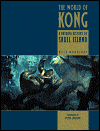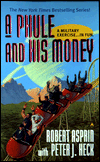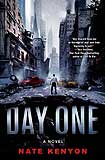
The World of King Kong, by WETA Workshop
Book Review by S C Bryce
Have you read this book?
WETA Workshop's The World of King Kong: A Natural History of Skull Island is as astonishing as Peter Jackson's "King Kong" film. The premise of the book is simple. It is presented as the sum of information gathered by the seven expeditions to Skull Island that followed Carl Denham's 1933 discovery of the island. Through these systematic explorations, scientists pieced together the island's geological development as well as a history of its flora and fauna dating from the island's separation from Gondwanaland through its eventual disappearance into the sea in the 1940s.
WETA Workshop makes the most of this broad premise. Skull Island is explained, categorized, analyzed, and dissected through sketches, maps, anatomical and architectural details, and jaw-dropping illustrations. The island is divided into ecological zones and then populated with an astonishing array of species, each complete with its Latin name. Most creatures have descriptions of varying lengths that may include mating, feeding, defense, and breeding behaviors as well as speculation as to how these vibrant and vicious creatures evolved and their evolutionary trade-offs. The bestiary is punctuated by entertaining quotes from the researchers' field journals.
WETA Workshop surveys everything from Skull Island's parasites to its massive dinosaurs, explaining how these creatures diverge from their more well-known ancestors such as T. Rex in order to deal with the particular evolutionary challenges of the remote island. WETA Workshop shines not only in its believable explanations and its detail, but its artwork. Weta manages to convey not just movement, but ferocity, savagery, and desperate survival. Not just animals, but downy plumage, stiff flight feathers, overlapping scales, and armored skin. Not just plants, but the heaviness of foliage in tropical humidity. Nor does Weta satisfy itself with ordinary angles. The reader is treated to a brontosaurus-eye view, a feast of carrion parrots, life as a dung beetle, a blood bath of deadly eels, and the rear view of a lamprey-type fish as it slithers into the reeds.
Despite this dissection Skull Island retains its mysterious and supernatural aura—usually lost in such fictional encyclopedic works. Life on Skull Island is, as philosopher Thomas Hobbes might say, "nasty, brutish and short."
Criticisms of the work are few. Clearly, there are too many gigantic species for Skull Island to support, even given the premise of the book. Additionally, both the species and the art repeat too often. Thus, what seemed ingenious at the beginning of the book seems ho-hum after 200 pages. The art in Kong's section seems cribbed directly from the film (or maybe prepared for use in the film).
Despite minor drawbacks, The World of King Kong is an outstanding companion to the film and a wonderful study of art and natural history. Therefore, I rate this book a 9.
WETA Workshop makes the most of this broad premise. Skull Island is explained, categorized, analyzed, and dissected through sketches, maps, anatomical and architectural details, and jaw-dropping illustrations. The island is divided into ecological zones and then populated with an astonishing array of species, each complete with its Latin name. Most creatures have descriptions of varying lengths that may include mating, feeding, defense, and breeding behaviors as well as speculation as to how these vibrant and vicious creatures evolved and their evolutionary trade-offs. The bestiary is punctuated by entertaining quotes from the researchers' field journals.
WETA Workshop surveys everything from Skull Island's parasites to its massive dinosaurs, explaining how these creatures diverge from their more well-known ancestors such as T. Rex in order to deal with the particular evolutionary challenges of the remote island. WETA Workshop shines not only in its believable explanations and its detail, but its artwork. Weta manages to convey not just movement, but ferocity, savagery, and desperate survival. Not just animals, but downy plumage, stiff flight feathers, overlapping scales, and armored skin. Not just plants, but the heaviness of foliage in tropical humidity. Nor does Weta satisfy itself with ordinary angles. The reader is treated to a brontosaurus-eye view, a feast of carrion parrots, life as a dung beetle, a blood bath of deadly eels, and the rear view of a lamprey-type fish as it slithers into the reeds.
Despite this dissection Skull Island retains its mysterious and supernatural aura—usually lost in such fictional encyclopedic works. Life on Skull Island is, as philosopher Thomas Hobbes might say, "nasty, brutish and short."
Criticisms of the work are few. Clearly, there are too many gigantic species for Skull Island to support, even given the premise of the book. Additionally, both the species and the art repeat too often. Thus, what seemed ingenious at the beginning of the book seems ho-hum after 200 pages. The art in Kong's section seems cribbed directly from the film (or maybe prepared for use in the film).
Despite minor drawbacks, The World of King Kong is an outstanding companion to the film and a wonderful study of art and natural history. Therefore, I rate this book a 9.
|
Click here to buy The World of King Kong, by WETA Workshop on Amazon
|
The World of King Kong, by WETA Workshop on Amazon

| More Books You Might Like |
Comment on The World of King Kong, by WETA Workshop
| Comments on The World of King Kong, by WETA Workshop |
| There are no comments on this book. |




